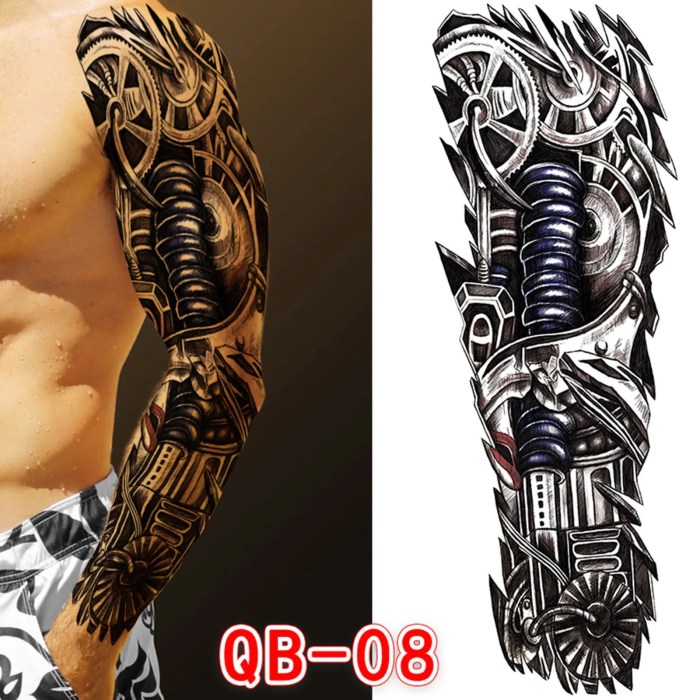Tattoo machine as prosthetic arm, a concept that blends artistry and engineering, presents a captivating vision for the future of prosthetics. This innovative approach leverages the precision and control of tattoo machines to create a new generation of prosthetic limbs, promising enhanced functionality and aesthetic appeal. Imagine a world where prosthetic arms not only restore lost function but also become extensions of personal expression, allowing individuals to seamlessly integrate technology with their bodies.
This paper explores the potential of tattoo machines as prosthetic arms, delving into the technical challenges, ethical considerations, and artistic possibilities. It examines the historical evolution of tattoo machines, their unique mechanical capabilities, and their potential application in a medical context. The paper also explores the societal implications of this technology, considering its impact on perceptions of disability, body modification, and human enhancement.
The Evolution of Tattoo Machines: Tattoo Machine As Prosthetic Arm
The history of tattoo machines is a fascinating journey that reflects the evolution of both art and technology. From rudimentary hand-operated tools to sophisticated electric devices, the quest for precision, speed, and artistic control has driven innovation in this field. This journey has resulted in a wide range of tattoo machines, each with its unique characteristics and applications.
Traditional Tattoo Machines
Traditional tattoo machines, also known as hand-tapped machines, were the earliest form of tattooing technology. These machines relied on the rhythmic tapping of a hand-operated lever to drive a needle into the skin. The basic design of a traditional tattoo machine involves a needle bar, a spring, and a lever. The lever is attached to a spring, which, when pressed down, drives the needle bar forward. This forward motion of the needle bar causes the needle to pierce the skin, depositing ink.
- Early Designs: The earliest known tattoo machines were simple, often consisting of a needle attached to a wooden handle, or a sharpened piece of bamboo or bone. These rudimentary tools were used to create simple designs, often with limited precision and control.
- The Invention of the Hand-Tapped Machine: The invention of the hand-tapped machine in the late 19th century marked a significant step forward in tattooing technology. These machines allowed for more control and precision, enabling artists to create more intricate designs.
- The Development of the Coil Machine: The coil machine, invented in the early 20th century, further revolutionized tattooing. This machine used electromagnetic coils to drive the needle, allowing for faster and more consistent needle movement.
Modern Electric Tattoo Machines
Modern electric tattoo machines have evolved from the coil machine, incorporating advancements in design, materials, and technology. These machines offer greater control, speed, and precision, allowing for more complex and intricate designs.
- Rotary Machines: Rotary machines use a motor to drive a rotating cam, which in turn moves the needle. This design provides a smoother and more consistent needle movement compared to coil machines.
- Pneumatic Machines: Pneumatic machines utilize compressed air to drive the needle. These machines are known for their power and versatility, allowing for a wide range of tattooing styles.
- Digital Tattoo Machines: Digital tattoo machines are the latest innovation in tattooing technology. These machines offer precise control over needle depth, speed, and other parameters, enabling artists to create highly detailed and realistic designs.
The Influence of Design on Application, Tattoo machine as prosthetic arm
The design of tattoo machines has a significant impact on their application in different contexts. For example, traditional hand-tapped machines are often used for specific styles, such as traditional Japanese tattoos, while rotary machines are popular for fine line and detailed work. The choice of tattoo machine depends on the artist’s style, the desired design, and the client’s preferences.
Concluding Remarks
The concept of tattoo machine as prosthetic arm is a testament to the boundless possibilities of human ingenuity. By merging the precision of tattooing with the needs of individuals with limb differences, this technology holds the potential to revolutionize prosthetics and empower individuals with a new level of control and self-expression. As research and development continue, we can expect to see further advancements in this field, paving the way for a future where prosthetic limbs are not only functional but also aesthetically integrated with the human body.
The idea of a tattoo machine as a prosthetic arm might sound strange, but it highlights the innovative potential of technology. Just like Google’s Larry Page is spending money on flying cars , it’s about pushing boundaries and finding new ways to solve problems.
Perhaps, one day, a tattoo machine could be adapted to provide a precise and intricate way for amputees to regain fine motor control.
 Securesion Berita Informatif Terbaru
Securesion Berita Informatif Terbaru
